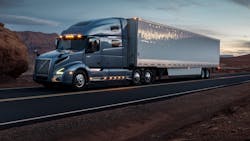How to increase fuel efficiency with a streamlined fleet
Fleets are constantly looking for ways to reduce fuel consumption while also improving operational efficiency. The industry has responded to that demand by creating aerodynamic technologies and vehicle designs.
“The fuel consumption of a commercial vehicle can contribute to [the total cost of operations],” said Patrick Kealy, North American OE trailer business leader for Commercial Vehicle Control Systems (CVCS). “Aerodynamic products reduce air drag which can lower fuel consumption and CO2 emissions, so any improvements through reduction of aerodynamic drag is favorable to fleets and drivers.”
CVCS (formerly WABCO) is a division of ZF that specializes in vehicle technology manufacturing and brakes.
Though aerodynamic technologies offer fleets advantages, it should be noted this is not true on all trucks, said Dave Walters, manager of warranty and field service for Alcoa Wheel Products.
“If you’re a city truck or a regional truck, you really don't see the benefits of these [aerodynamic] devices,” Walters explains. “But if you're the over-the-road type of truck, there is definitely an advantage.”
Streamlining with aerodynamic products
When it comes to adding aerodynamic products to a vehicle, fleets have a variety of choices to mix and match to find what works best for them.
“A variety of areas on the tractor can be improved, including how the air hits the tractor, travels down the side of the tractor, and then transfers to the trailer,” said Allison Athey, product marketing manager for Volvo Trucks North America. “This translates on a Volvo tractor into bumpers with air deflectors underneath, chassis fairings with ground effects, cab side fairings with extenders, roof fairings with a trim tab, and the FlowBelow Tractor Aerokit.”
On other trucks, an aerodynamic setup may look quite different. According to Walters, who acted as chairman for the Technology and Maintenance Council’s (TMC) Recommended Practice (RP) 261, Considerations for Aerodynamic Wheel Covers, he worked with many fleets on this committee, and they found skirting and wheel covers to be beneficial.
However, what works best for one fleet may not be best for another.
“As you start adding different components on, it’s not intuitive as to what will actually reduce drag,” said Doug Mason, global technical manager for Alcoa Wheel Products.
He uses the example of a fleet that adds a trailer skirt and sees 5 percent savings. The fleet then adds another component that should provide an additional 2 percent savings, but instead of seeing a total 7% in savings, they only realize 4 percent. The interaction between the two components did change the airflow, but because of the complexity of the truck and trailer designs themselves, the addition of the second aerodynamic device actually created more drag, Mason explains.
In the end, fleets looking to streamline their vehicles will need to go through some trial and error in order to find a good fit.
“The aerodynamics of trucks are just so complex, and the best data out there … belongs to the fleets,” said Mike Yagley, global program launch manager for Alcoa Wheel Products. “They know exactly what they get for the aerodynamics, when they add a hub cover … and they are going to know how that works with their boat tail, and they are going to know how that works at the fairing. And when they take [it] off, and they do all sorts of studies, they get all that data. They are really the experts.”
OEM vs. aftermarket aerodynamic products
OEM and aftermarket aerodynamic products each have their own benefits and drawbacks.
“The benefit of installing at the OEM assembly plant is that it is a more controlled environment with a process that helps to ensure proper installation for maximum efficiency,” CVCS’s Kealy said. “The ZF products are CARB and Smartway certified and not all competitive products are, including some sold through the aftermarket.”
Additionally, Volvo’s Athey points out, OEM products have been tested and verified by the OEMs for efficiency benefits and durability. Those products also have a factory warranty.
Sometimes though, it isn’t about whether the product is OEM or aftermarket.
“It’s how easily it is assembled onto the vehicle,” Alcoa’s Mason said. “Is that component going to be easy to maintain? If it is not, they are not going to order it from the OEM, and they are not going to buy it from the aftermarket. I don't know if there is really a question [of] either/or … it is the effectiveness.”
Installation and upkeep of aerodynamic devices
Proper installation and maintenance of aerodynamic devices are essential to achieving improved fuel efficiency.
Before installing any aerodynamic devices, fleets should be sure the device will give them the benefits desired, Kealy said. This means there should be documented and certified proof of fuel savings for that application. Next, fleets should follow the manufacturer’s installation guidelines, as designs can vary depending on trailer type and application.
Once the aerodynamic devices have been installed, upkeep is crucial.
“Don't ignore the aerodynamic devices during the scheduled periodic maintenance of the truck or trailer,” Kealy said. “Follow recommended service and inspection intervals. Perform visual inspection for any damage or signs of impact to the product, check bolt torques, and check the fit and clearance from the device to the truck or trailer. Check for cracks, dents, and deformations that would reduce overall airflow; the clearance and flow around the devices are what improves the aerodynamics and improves fuel economy.”
While using aerodynamic devices, fleets must also be aware that of the issues that come along with maintaining them. According to TMC’s RP 1110 – Inspection and Maintenance Recommendations for Aerodynamic Devices – there are three reasons aerodynamic devices can increase maintenance requirements.
- Some aerodynamic devices themselves are easily damaged and require replacement.
- The devices can damage parts of the vehicle to which they are mounted, such as the cab roof or the back of the cab.
- Devices may obstruct access to items on the vehicle requiring maintenance, increasing time required to perform maintenance.
TMC also notes that ground clearance is becoming an issue, as some aerodynamic devices are causing tractors decreased maneuverability into locations that were accessible before the devices were added.
With this information in mind, fleets must do their research prior to adding aerodynamic devices to their vehicles. If a fleet does decide to add them, proper installation and maintenance are key.
About the Author
Emily Markham
Assistant Editor | Vehicle Repair Group
Emily Markham is an assistant editor for the Vehicle Repair Group.
With an education based in writing and editing, Markham uses her knowledge to assist with the creation of content for Endeavor Business Media Vehicle Repair Group’s publications—Fleet Maintenance, Professional Tool & Equipment News (PTEN), and Professional Distributor—as well as their website, VehicleServicePros.com.

